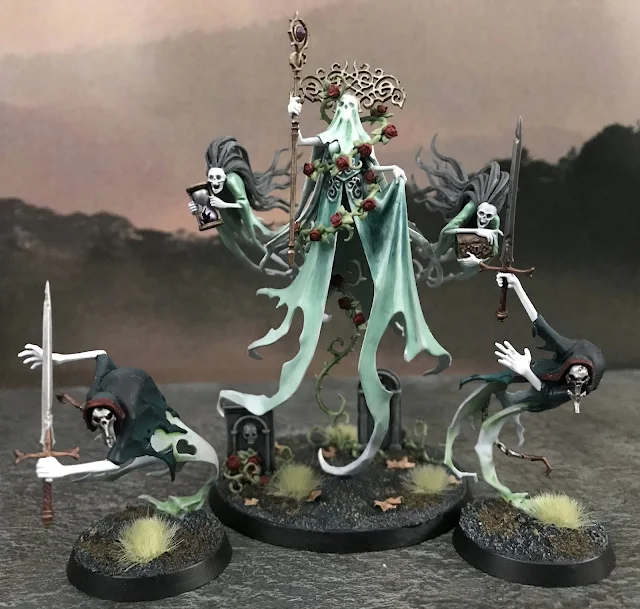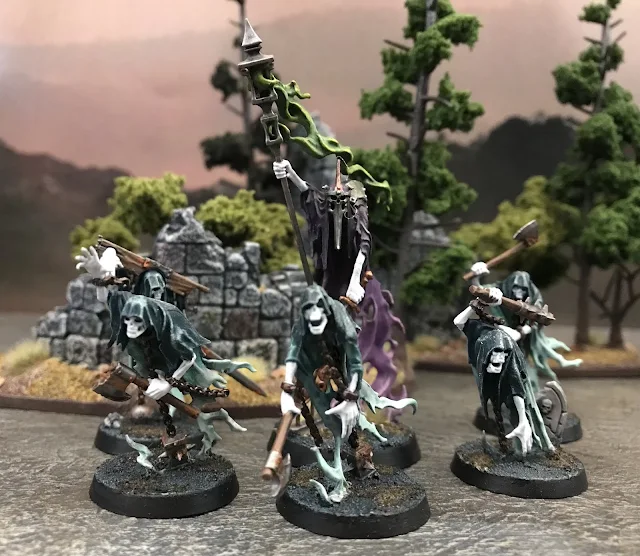The grand finale to this year's Spooktober event is here, and much like last year, I'll be covering the lore of one of my Age of Sigmar armies. This is now the third part in the series, which has thus far covered the kingdoms of Heldenmarch and Ravenmarch.
Ravenmarch, the progenitor to Heldenmarch in the Silverlight Realm, is now a cursed land in conflict with the lands of the living. However, the country is not a monolithic entity, and there are conflicts and wars, even amongst the dead. This post will dive into the history, conflicts, and even rules for brining the foremost of these factions to life on the tabletop: The Court of the White Lady.
Geography
Tucked in the far north-eastern quadrant of the Silverlight region sits the decrepit kingdom of Ravenmarch. Once a mighty empire in its own right that stretched into Menhir and beyond the Scrape, it is now relegated to the lands east of the River Stromlos.
Ravenmarch was once split into five distinct regions: Northmarch, Eastmarch, Southmarch, Westmarch, and the Crownmarch in the center. Only the Eastmarch remains fully within the kingdom.
The northern border is crowned by the Auric Sea, which the original founders of Ravenmarch sailed across from distant lands. Once plied by fishing ships, many of the harbors now lay silent.
The eastern border is more ambiguous, as open steppes give way to forests and ravines. As such, the Eastmarch had always been largely uninhabited.
To the south lie the desolate mountains of the Scrape. Dense pine forest covers much of the land, but rich mining towns once thrived here.
Finally, the western border is the River Stromloss. Across this river sits mighty Heldenmarch, forever a reminder of the glory that once belonged to the Children of the Raven.
The Court of the White Lady is a specific subset of the Ravenmarch kingdom, whose capital is Hexenheim. It's territory extends into the eastern portion of the Northmarch region, also claiming the old city of Rothenztyn, along with the towns of Muldorf and Valden.
History
Centuries ago, men, dwarves, and elves sailed across the Auric Sea, fleeing some long forgotten terror in their old homelands. They made landfall and established a city, named Rothenztyn in honor of their leader. In time, the people would claim the coast, establishing the towns of Muldorf and Valden, named for the son of Rothen.
At the passing of Rothen, Valden was consumed with despair. Praying to his gods but finding no answer, he fled into the wilds, intending to die. However, he witnessed a great migration of ravens and crows, and he set out to follow them. For days he ventured, until the great flock landed upon the boughs of a mighty oak tree.
Within a knot of the tree was a pool of amethyst, the faintest whispers rising from within. Entranced, he spoke back to the pool, and was shocked to hear the voice of his father. He had found a portal to the realm of the dead.
From this discovery grew the city that would become known as Oldztyn, as well as the religion of the Amethyst Cult. The keepers of the portal, the Cult grew in power and knowledge. Soon, not only could they commune with ancestors, but draw spirits back into the realm of the living. In a quest for ever greater power, the Cult would gradually use these spirits as a source of energy for magic and dread machinations.
Then, on the day now called Hexennacht, the dead broke free from their chains. In their bid for power, the Cult had finally drawn too much, calling upon the spirits of great souls such as kings and ancient heroes. Too proud to be bound in such a manner, these souls raged against their captors. An outpour of death energy roiled across the land as they tore free, and millions of souls returned to their decrepit bodies.
But not all souls could find their bodies. Whether from complete destruction of the body, or prevented by magical means, those tortured spirits were cursed to roam the land, never to find rest. Many went insane, but a powerful spirit, now only known as the White Lady, was able to lead these misguided souls.
The White Lady knew her body was buried within the halls of Olztyn, and in a twist of irony, she herself had set the magical wards to protect her corpse from decay but which now prevented her from returning to her body. Vathek Grimst, now resurrected and claiming lordship over all of Ravenmarch, knew of this as well, and offered a pact to the White Lady: in return for commanding the legions of ghosts now rampant across the country, he would return her body after a year's time.
Alas, for within a year, Vathek had seen the effectiveness of the spectral forces. Serving as shock and terror troops, they had been instrumental in the wars with the living. After a year, he refused to return the body to the White Lady. Enraged, she withdrew her forces to her home city of Hexenheim, and the war with the living ground to a halt. It was this that led to the cessation of conflict between the living and the dead as neither side now had the numbers to win. An uneasy peace settled, and Heldenmarch was founded.
Within old Ravenmarch, was still raged. The Court of the White Lady, composed of her courtiers and knights from life, swept through the Northmarch, claiming territory and gathering more souls to her banner. Perhaps one day, she will have enough strength to challenge the throne directly and end her ethereal torment.
Military Structure
With many spirits driven to madness by the lack of body, the military of the Court is top-heavy, with those few with any remaining sanity assuming roles of leadership. The White Lady herself is driven by her desire to return to her body. She is an incredibly gifted sorceress, and is accompanied by her sisters. She has an uncanny ability to direct even the most insane of souls, soothing their torment. She is well loved amongst her people, if one could call them that, and devotion to her has returned some souls mental capacity. Those who do so can climb through the ranks of the military, and the close they come to the inner court the more sane they become, imbued with a sense of purpose.
Many of the knights who served the White Lady in life still serve in death, their vows of servitude sustaining their minds. Some still have their steeds, an unfortunate scenario for both horse and rider. The knights rule over the ruins of castles throughout the lands, and when called upon will amass troops from their "serfs", those poor souls whose minds are completely lost.
The most reviled but necessary souls are those from the Amethyst Cult, whose actions brought about the current hell that these spirits find themselves in. For those members of the Cult who arose without their body, they found a world in which both the living and the dead hated them. These spirits fled to the wilds, practicing necromancy in attempts to possess any body. However, the natural order abhorred a soul inhabiting a body not it's own, and their efforts proved in vain. But not fruitless. They found they could help sustain souls and calm minds, and so in an effort to gain penance swore allegiance to the White Lady. Not quick to forgive them entirely, she cast a spell, tainting their spirits amethyst, so that all can witness their crimes for eternity.
Current Events
The Court of the White Lady continues to surge across the land, gathering souls, lost artifacts, and forgotten lore in an attempt to retake the city of Olztyn. The White Lady is not the only spirit whose bodies are interred within the great cemetery, and the goal brings a measure of peace to many of the souls.
The primary enemy is of course the undead forces of Vathek Grimst. The Court has been a constant thorn in his side, preventing him from devoting all of his considerable resources at retaking all of Heldenmarch. Unknown to the lands of the living, it is these efforts that keep them free.
Unfortunately, not all of the human nations look kindly upon the dead. The nation of Arequine, whose penchant for wearing relics of the hallowed dead upon their armor for protection, is particularly keen to loot the lands of Ravenmarch. Especially for tombs of heroes. Battle Pilgrimages are common incursions, and the Court has had its fair share of run-ins with the knights of Arequine.
Rules for Playing in Northmarch
Below are some rules for playing games of Age of Sigmar in the Silverlight setting. These are narrative focused, so don't expect them to be necessarily be balanced. As always, you should always talk with your opponent before trying any new rules. Feel free to mix and match as you please!
To determine where you are fighting within Northmarch, roll a d3 and reference the table below for effects on gameplay. Instead of randomly rolling, you may choose a result from the table to match the style of game you desire.
1. Cemetery: Set up the battlefield with tombstone scatter terrain. Death armies can add 1 wound to any abilities that allow you to return models to the game.
2. Hexenheim, the Accursed City: Set up ruins terrain throughout the battlefield. The warped energies of the cataclysm render magic unreliable. Subtract 1 from any casting rolls, and miscasts can occur on rolls of a double 2 as well.
3. Ports of Rothenztyn: Declare one short edge of the board to be the "sea" side. Every turn, fog from the sea encroaches further onto land. Measure 12" from the edge of the board; shooting attacks have their ranges reduced by half within this region. Beginning from the first turn, add 6" to this range.
-The Space Dinosaur











No comments:
Post a Comment